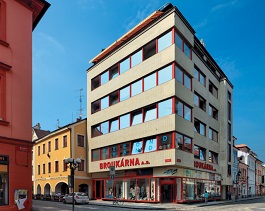
In the Budějovice department store from the 1930s, there is a shop, a bar, and companies
 |
It was one of eight department stores of the B+B company named after its two owners, designed by architect Karel Chochola. After nationalization, it was renamed Vltavan, then in 1980 to Dětský dům. In 1983, it was closed due to a state of emergency, and after repairs, it reopened in 1989.
Zdeněk Kult purchased the building in 2009, investing tens of millions into it. The building, which is no longer a protected monument, is now profitable.
"I bought it because I wanted to invest and I have a connection to functionalism; the first house I lived in was a functionalist villa," said Kult (59). "The house was in a state of complete disrepair back then," added the man, who was originally a chief designer of machine tools at the České Budějovice company Igla and started his business after 1989.
People occasionally ask why there aren't more stores in the building. According to the owner, however, the building must be profitable for the investment to be recouped. Kult wanted to create a background for companies. Last year, he opened a new elevator and plans to modify the interiors. Some windows are original, opening from the top with a rod behind a metal handle. Kult is glad that a bar operates in the basement, keeping the building alive both day and night. The bar used to be on the ground floor, where theater actor Karel Roden Sr. once celebrated the birth of his son Karel, now a well-known actor.
Architect Mirek Vodák reminded ČTK that while in the Middle Ages, shops occupied about 50 square meters on the ground floor of a house, at the beginning of the 20th century, the four-story Baťa department store occupied ten times more space, and today a typical shopping center is a hundred times larger.
"Contemporary department stores seem to be robbing historical city centers and creating their own streets. I see this as a phenomenon of the modern department store. Tenants do not choose some old department stores, like Brouk a Babka, because they do not meet the concept of verticality on a small parcel – they are looking for shopping galleries that create an artificial street where it doesn’t rain, and there's also parking," said Vodák.
In Tábor, which has about 35,000 inhabitants, a purely commercial department store did not emerge during the first republic. Only in the 1920s, when the city savings bank was completed, were there two shops on the ground floor. Jitka Vandrovcová, a historian of modern history at the Hussite Museum in Tábor, told ČTK, "Shops were built more in the infill, on the ground floors of apartment buildings," said the historian.
The English translation is powered by AI tool. Switch to Czech to view the original text source.
0 comments
add comment












